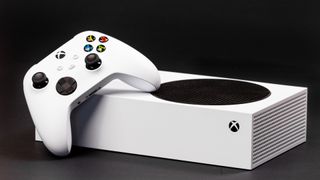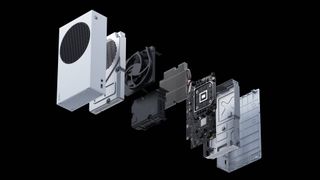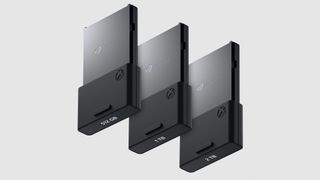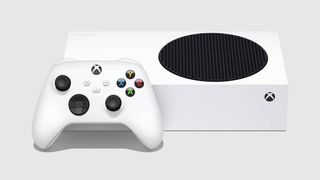
A look at the Xbox Series S specs might initially give the impression that it’s not worth buying when compared to other consoles available this generation, such as its more powerful sibling, the Xbox Series X, as well as its competition in the form of the PS5. However, when you consider the relatively lower price of the console, the Xbox Series S’s specs are a welcome surprise.
We’ve previously considered whether or not the Xbox Series S is still worth buying in 2022 where we briefly touched on the console’s specs and how they stack up against other systems. Now, we’ll go into a more comprehensive breakdown of the ins and outs of the pint-sized machine to help you understand if its specs line up with what you’re looking for.
Alongside the Xbox Series X, the Xbox Series S is one of the newest Xbox consoles you can buy, and as a result, it’s packing some seriously impressive specs that, while not quite as potent as its premium counterpart, is a good step above the Xbox One X and far outpaces the capabilities of the Nintendo Switch. The Xbox Series S could be viewed as a halfway house of sorts, then, featuring slightly pared down specs for its lower price.
Xbox Series S specs at a glance
- CPU: AMD Custom Zen 2 CPU, 8x Cores @ 3.6GHz
- GPU: AMD Custom RDNA 2 GPU, 4 teraflops
- Memory: 10GB GDDR6 128 bit-wide bus
- Storage: 512GB Custom NVMe SSD
- Resolution: Up to 1440p
- Performance: Up to 120fps
- HDMI: HDMI 2.1 supported
- HDMI features: auto low-latency mode, VRR, AMD FreeSync
- Audio: L-PCM 7.1, DTS 5.1, Dolby Digital 5.1, Dolby Atmos
- Ports: 1x HDMI 2.1, 3x USB 3.1 Gen 1, Ethernet, Wireless 802.11ac dual band
- Dimensions: 6.5cm x 15.1cm x 27.5 cm
- Weight: 4.25 lbs (1.93kg)
Xbox Series S CPU

The Xbox Series S features a custom version of AMD’s Zen 2 CPU. The custom Zen 2 8-core CPU boasts a clock speed of 3.6GHz, and is comparable to CPUs in AMD’s Ryzen 3000 series, such as the Ryzen 7 3800X 8-core CPU. That’s a slight step down from the Xbox Series X’s 3.8GHz clock speed, which can result in slightly lower frame rates in comparable games.
Xbox Series S GPU
It’s the GPU where there’s a more noticeable difference between the Xbox Series S and Xbox Series X. Microsoft has also opted for custom AMD architecture in both consoles, and the Xbox Series S’s custom RDNA 2 GPU features just 4 teraflops of power compared to the Xbox Series X’s more impressive 12.15 teraflops.
The Xbox Series S falls short in terms of graphical prowess not only to its counterpart, but also last generation’s Xbox One X, which was 4K ready and boasted 6 teraflops of power. By no means does the Xbox Series S underperform, though. It’s still capable of outputting a 1440p resolution at up to 120Hz, but it’s a major reason why the Xbox Series S costs so little in comparison to the beefier consoles.
The Xbox Series S also has less RAM than the Xbox Series X - just 10GB compared to 16GB. This is another reason why 4K visuals aren’t really feasible on Microsoft’s more affordable machine. Less of the console’s faster RAM isn’t available to developers, even less than the 4K capable Xbox One X. This is a big reason as to why 1440p is a more realistic target for the Xbox Series S.
Get the best Black Friday deals direct to your inbox, plus news, reviews, and more.
Sign up to be the first to know about unmissable Black Friday deals on top tech, plus get all your favorite TechRadar content.
Xbox Series S storage

Xbox Series S’s custom PCIe 4.0 NVMe SSD is identical to Xbox Series X in all but storage space. While the Xbox Series X features an adequate 1TB of storage space, the Xbox Series S does struggle a bit at just 512GB without expandable storage devices like the Seagate Xbox Storage Expansion Card.
This means that space is going to get used up fast if you plan on installing and playing a decent amount of games, leaving the SSD feeling a little cramped. And if you subscribe to the stellar Xbox Game Pass service, you’ll likely find yourself deleting games semi-frequently to make space for new ones.
However, the Xbox Series S’s NVMe SSD picks up the slack when it comes to performance. The SSD is blazingly quick, and able to load content more swiftly and efficiently than last generation’s hard disk drives, which are positively glacial by comparison. Expect most loading screens, even in big-budget AAA titles, to last mere seconds. Even initial load times after booting up a game rarely stray above half a minute, meaning the Xbox Series S’s speed is a fantastic selling point.
Xbox Series S resolution and performance

Most current-gen games on the Xbox Series S can be played at 1440p resolution, with some particularly demanding games dropping to a still respectable 1080p, either by default or in a framerate-boosting Performance mode setting. There are some edge cases, though, such as with games like Ori and the Will of the Wisps or The Touryst, both of which can output a 4K resolution on Microsoft’s fairer priced machine.
In terms of performance, the Xbox Series S is remarkably slick. With a HDMI 2.1 cable, the Xbox Series S is capable of running supported titles at 120fps. Additionally, HDMI 2.1 grants variable refresh rate, an auto low latency mode to reduce input lag from wireless controllers and - thanks to the in-built AMD components - FreeSync technology for a much smoother, consistent framerate, free of screen tearing.
The Xbox Series X is still a very capable console, then. Not only can the machine target 120fps, it’s also capable of ray tracing in applicable games, and as demonstrated by The Matrix Awakens tech demo, is somewhat future-proofed for Unreal Engine 5 games.
Xbox Series S design
One of the best aspects of the Xbox Series S has to be its form factor. With dimensions of 6.5cm x 15.1cm x 27.5 cm, it’s a much, much slimmer unit than the Xbox Series X and PS5. In fact, it’s the smallest Xbox ever made. This compact design is ideal if you’re looking for a smaller console as part of your home setup, or if you don’t have that much space in general.
Similarly impressive is the Xbox Series S’s weight of 4.25lbs. That’s just under 2kg, and means it’s less than half the weight of the bulky Xbox Series X, which comes in at a whopping 9.8lbs (4.45kg).
Overall, the Xbox Series S features a brilliantly minimal design that complements its pared down specs when compared to the bigger fish. Aspects of the Xbox Series S’s design can very much be viewed as a tradeoff, then. Yes, you’re not quite getting the 4K power of the Xbox Series X or PS5, but the silver lining there is a space-friendly unit that’s still capable of next-gen features and won’t break the bank.

Rhys is TRG's Hardware Editor, and has been part of the TechRadar team for more than two years. Particularly passionate about high-quality third-party controllers and headsets, as well as the latest and greatest in fight sticks and VR, Rhys strives to provide easy-to-read, informative coverage on gaming hardware of all kinds. As for the games themselves, Rhys is especially keen on fighting and racing games, as well as soulslikes and RPGs.
Final Fantasy 14 on Xbox Series X|S will require Xbox Game Pass to play when it launches in full
Most Popular


